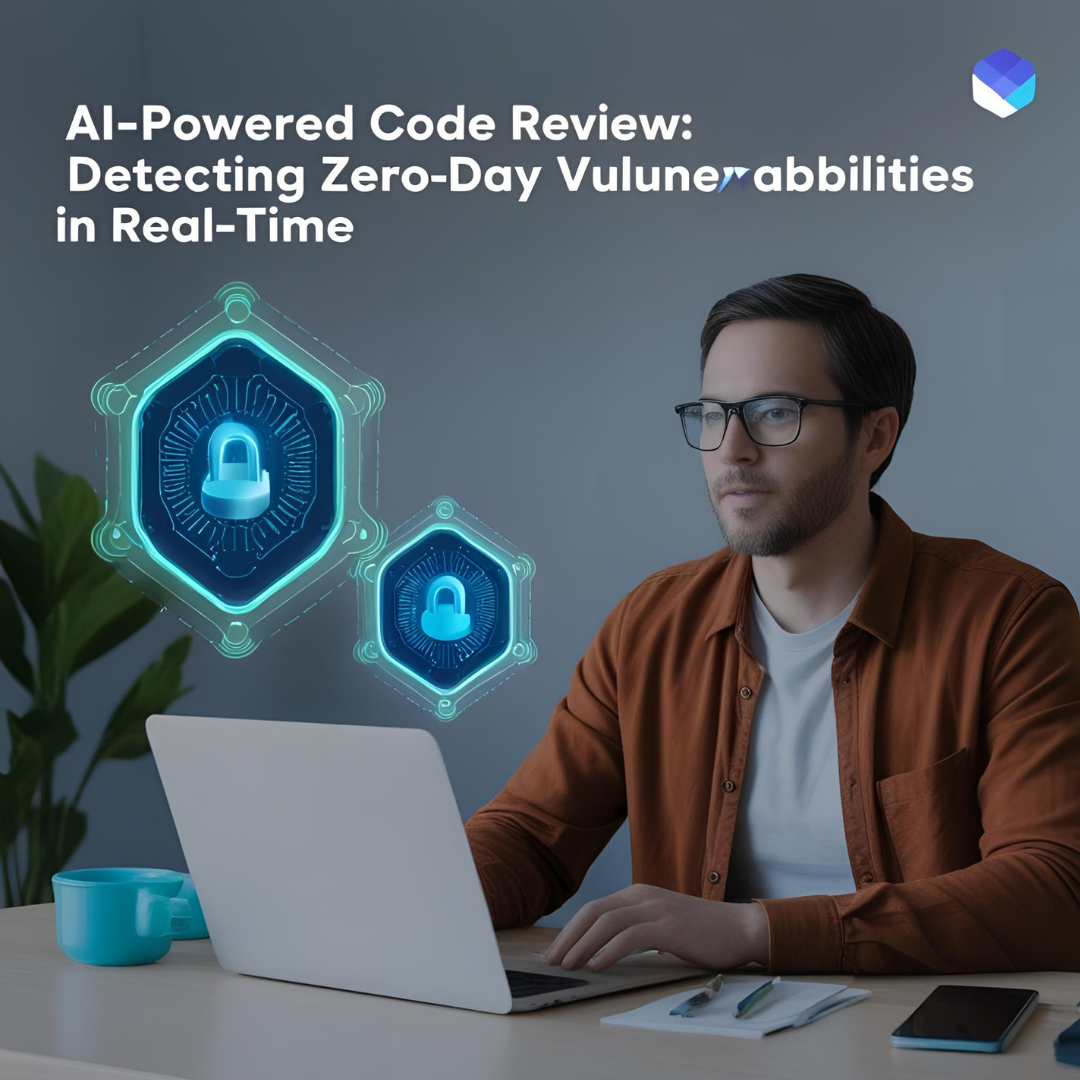Introduction
Traditional code review processes, while essential, often struggle to keep pace with modern development cycles and the evolving landscape of cyber threats. Zero-day vulnerabilities—security flaws unknown to vendors and without available patches—pose significant risks to organizations worldwide. The integration of Artificial Intelligence (AI) into code review processes represents a paradigm shift in how we approach vulnerability detection, offering real-time analysis capabilities that can identify potential zero-day threats before they reach production.
AI-powered code review tools leverage machine learning algorithms, natural language processing, and pattern recognition to analyze code at scale, detecting subtle security patterns that might escape human reviewers. These systems can process thousands of lines of code in seconds, continuously learning from new vulnerability patterns and adapting to emerging threat vectors.
Understanding AI-Powered Code Review
How AI Transforms Code Review
AI-powered code review systems operate through several key mechanisms:
Pattern Recognition: Machine learning models trained on vast datasets of known vulnerabilities can identify similar patterns in new code, even when the implementation details differ significantly from known exploits.
Contextual Analysis: Unlike traditional static analysis tools that examine code in isolation, AI systems can understand the broader context of how different code components interact, identifying vulnerabilities that emerge from complex interactions between modules.
Behavioral Analysis: AI models can simulate code execution paths and identify potentially dangerous behaviors, such as unvalidated input processing, improper memory management, or insecure data handling practices.
Continuous Learning: These systems continuously update their knowledge base with new vulnerability patterns, ensuring they remain effective against emerging threats.
The Zero-Day Challenge
Zero-day vulnerabilities represent a unique challenge because they exploit previously unknown security flaws. Traditional signature-based detection methods fail against these threats since no signatures exist. AI-powered systems address this challenge by:
- Analyzing code structure and flow patterns rather than relying on known signatures
- Identifying anomalous code patterns that deviate from secure coding practices
- Detecting potential attack vectors based on code complexity and data flow analysis
- Recognizing subtle indicators that might suggest exploitable conditions
Leading AI-Powered Code Review Tools
1. GitHub Copilot Security
Overview: GitHub Copilot Security extends the popular AI coding assistant with security-focused capabilities, providing real-time vulnerability detection as developers write code.
Key Features:
- Real-time vulnerability scanning during code development
- Integration with GitHub’s security advisory database
- Support for multiple programming languages
- Contextual security suggestions
Implementation Process:
# Install GitHub CLI
curl -fsSL https://cli.github.com/packages/githubcli-archive-keyring.gpg | sudo dd of=/usr/share/keyrings/githubcli-archive-keyring.gpg
echo "deb [arch=$(dpkg --print-architecture) signed-by=/usr/share/keyrings/githubcli-archive-keyring.gpg] https://cli.github.com/packages stable main" | sudo tee /etc/apt/sources.list.d/github-cli.list > /dev/null
sudo apt update
sudo apt install gh
# Authenticate with GitHub
gh auth login
# Enable Copilot Security for your repository
gh copilot enable-security --repo your-org/your-repo
Configuration Example:
# .github/workflows/copilot-security.yml
name: Copilot Security Scan
on:
push:
branches: [ main, develop ]
pull_request:
branches: [ main ]
jobs:
security-scan:
runs-on: ubuntu-latest
steps:
- uses: actions/checkout@v4
- name: Run Copilot Security Scan
uses: github/copilot-security-action@v1
with:
token: ${{ secrets.GITHUB_TOKEN }}
scan-level: 'comprehensive'
fail-on-severity: 'medium'
2. Snyk Code
Overview: Snyk Code uses AI and machine learning to perform static application security testing (SAST) with a focus on finding security vulnerabilities in real-time.
Key Features:
- AI-powered static analysis
- Real-time scanning in IDEs
- Fix suggestions with code examples
- Integration with CI/CD pipelines
Setup and Configuration:
# Install Snyk CLI
npm install -g snyk
# Authenticate with Snyk
snyk auth
# Initialize Snyk in your project
snyk init
# Run code analysis
snyk code test
IDE Integration (VS Code):
// .vscode/settings.json
{
"snyk.enable": true,
"snyk.codeSecurityEnabled": true,
"snyk.codeQualityEnabled": true,
"snyk.scanOnSave": true,
"snyk.severity": {
"critical": true,
"high": true,
"medium": true,
"low": false
}
}
CI/CD Integration:
# .github/workflows/snyk-security.yml
name: Snyk Security Scan
on: [push, pull_request]
jobs:
security:
runs-on: ubuntu-latest
steps:
- uses: actions/checkout@v4
- name: Run Snyk to check for vulnerabilities
uses: snyk/actions/node@master
env:
SNYK_TOKEN: ${{ secrets.SNYK_TOKEN }}
with:
args: --severity-threshold=medium
3. Checkmarx CxSAST AI
Overview: Checkmarx leverages AI to enhance its static application security testing capabilities, providing intelligent vulnerability detection with reduced false positives.
Key Features:
- AI-enhanced static analysis
- Machine learning-based false positive reduction
- Comprehensive language support
- Integration with development workflows
Configuration Steps:
<!-- checkmarx-config.xml -->
<CxSAST>
<ScanSettings>
<PresetName>High Sensitivity</PresetName>
<EngineConfiguration>AI_Enhanced</EngineConfiguration>
<IncludeSourceFolders>
<Folder>src/main/java</Folder>
<Folder>src/main/resources</Folder>
</IncludeSourceFolders>
<ExcludeSourceFolders>
<Folder>target</Folder>
<Folder>node_modules</Folder>
</ExcludeSourceFolders>
</ScanSettings>
<AISettings>
<EnableMLAnalysis>true</EnableMLAnalysis>
<FalsePositiveReduction>true</FalsePositiveReduction>
<ZeroDayDetection>true</ZeroDayDetection>
</AISettings>
</CxSAST>
4. Veracode Static Analysis
Overview: Veracode’s AI-powered static analysis platform provides comprehensive vulnerability detection with machine learning-enhanced accuracy.
Key Features:
- AI-powered vulnerability detection
- Continuous scanning capabilities
- Developer-friendly remediation guidance
- Enterprise-grade security and compliance
Integration Example:
# Install Veracode CLI
curl -fsS https://tools.veracode.com/veracode-cli/install | sh
# Configure API credentials
veracode configure
# Run static analysis
veracode static scan --source . --app-name "MyApplication"
5. SonarQube with AI Enhancement
Overview: SonarQube’s latest versions incorporate AI capabilities to improve code quality and security analysis.
Setup Process:
# Download and start SonarQube
docker run -d --name sonarqube -p 9000:9000 sonarqube:latest
# Install SonarScanner
npm install -g sonarqube-scanner
Project Configuration:
# sonar-project.properties
sonar.projectKey=my-project
sonar.projectName=My Project
sonar.projectVersion=1.0
sonar.sources=src
sonar.language=java
sonar.sourceEncoding=UTF-8
# AI-enhanced analysis settings
sonar.ai.enabled=true
sonar.ai.zeroday.detection=true
sonar.ai.falsepositive.reduction=true
Implementation Best Practices
1. Gradual Integration
Start with a pilot project to evaluate the effectiveness of AI-powered code review tools before rolling out organization-wide. This approach allows teams to:
- Assess tool accuracy and false positive rates
- Train development teams on new workflows
- Customize tool configurations for specific project needs
- Establish baseline security metrics
2. Multi-Tool Approach
Different AI-powered tools excel in different areas. Consider implementing multiple tools to achieve comprehensive coverage:
- Primary Tool: Use one main tool for continuous integration
- Secondary Tool: Deploy a second tool for periodic deep analysis
- Specialized Tools: Add domain-specific tools for particular technologies or frameworks
3. Continuous Training and Feedback
AI systems improve through continuous learning. Establish processes for:
- Regularly updating training datasets with new vulnerability patterns
- Providing feedback on false positives and false negatives
- Incorporating organization-specific security patterns and requirements
- Monitoring and adjusting detection thresholds based on team feedback
4. Integration with Development Workflows
Seamlessly integrate AI-powered code review into existing development processes:
Pre-commit Hooks:
#!/bin/bash
# .git/hooks/pre-commit
echo "Running AI-powered security scan..."
snyk code test --json > /tmp/security-scan.json
if [ $? -ne 0 ]; then
echo "Security vulnerabilities detected. Please review and fix before committing."
cat /tmp/security-scan.json | jq '.vulnerabilities[] | select(.severity=="high" or .severity=="critical")'
exit 1
fi
Pull Request Integration:
# .github/workflows/pr-security-check.yml
name: PR Security Check
on:
pull_request:
types: [opened, synchronize]
jobs:
security-review:
runs-on: ubuntu-latest
steps:
- uses: actions/checkout@v4
- name: AI Security Analysis
run: |
# Run multiple AI-powered tools
snyk code test --json > snyk-results.json
checkmarx scan --project-name "${GITHUB_REPOSITORY}" --output cx-results.json
# Combine results and generate report
python scripts/combine-security-results.py
- name: Comment PR with Results
uses: actions/github-script@v6
with:
script: |
const fs = require('fs');
const results = JSON.parse(fs.readFileSync('combined-results.json', 'utf8'));
const comment = `## 🔍 AI-Powered Security Analysis Results
**Critical Issues**: ${results.critical}
**High Issues**: ${results.high}
**Medium Issues**: ${results.medium}
${results.summary}
Please address critical and high-severity issues before merging.`;
github.rest.issues.createComment({
issue_number: context.issue.number,
owner: context.repo.owner,
repo: context.repo.repo,
body: comment
});
Advanced Configuration and Customization
Custom Rule Development
Many AI-powered tools allow for custom rule development to address organization-specific security requirements:
Snyk Custom Rules Example:
// custom-rules/sensitive-data-exposure.js
module.exports = {
meta: {
type: 'security',
severity: 'high',
description: 'Detects potential sensitive data exposure in logs'
},
create(context) {
return {
CallExpression(node) {
if (node.callee.property && node.callee.property.name === 'log') {
const args = node.arguments;
for (let arg of args) {
if (arg.type === 'Identifier' &&
/password|token|key|secret|credential/i.test(arg.name)) {
context.report({
node: arg,
message: 'Potential sensitive data exposure in log statement'
});
}
}
}
}
};
}
};
Machine Learning Model Customization
Advanced users can customize AI models for specific use cases:
# custom-model-training.py
import tensorflow as tf
from sklearn.model_selection import train_test_split
import pandas as pd
# Load vulnerability dataset
vulnerability_data = pd.read_csv('vulnerability_patterns.csv')
code_features = pd.read_csv('code_features.csv')
# Prepare training data
X = code_features.drop(['vulnerable'], axis=1)
y = code_features['vulnerable']
X_train, X_test, y_train, y_test = train_test_split(X, y, test_size=0.2, random_state=42)
# Build custom model
model = tf.keras.Sequential([
tf.keras.layers.Dense(128, activation='relu', input_shape=(X_train.shape[1],)),
tf.keras.layers.Dropout(0.3),
tf.keras.layers.Dense(64, activation='relu'),
tf.keras.layers.Dropout(0.3),
tf.keras.layers.Dense(32, activation='relu'),
tf.keras.layers.Dense(1, activation='sigmoid')
])
model.compile(optimizer='adam',
loss='binary_crossentropy',
metrics=['accuracy', 'precision', 'recall'])
# Train model
history = model.fit(X_train, y_train,
batch_size=32,
epochs=50,
validation_data=(X_test, y_test),
verbose=1)
# Save model for deployment
model.save('custom_vulnerability_detection_model.h5')
Real-Time Monitoring and Alerting
Setting Up Real-Time Alerts
Configure real-time alerts for critical security findings:
# alerting-config.yml
alerts:
- name: critical-vulnerability-detected
condition: severity == "critical"
channels:
- slack: "#security-alerts"
- email: "security-team@company.com"
- webhook: "https://api.company.com/security/alerts"
- name: zero-day-pattern-detected
condition: ai_confidence > 0.8 AND pattern_type == "zero_day"
channels:
- pagerduty: "security-escalation"
- slack: "#security-alerts"
priority: high
Monitoring Dashboard Setup
Create monitoring dashboards to track AI-powered code review effectiveness:
// dashboard-config.js
const dashboardConfig = {
widgets: [
{
type: 'metric',
title: 'Vulnerabilities Detected',
metric: 'security.vulnerabilities.total',
timeRange: '24h'
},
{
type: 'chart',
title: 'AI Confidence Distribution',
data: 'security.ai.confidence_scores',
chartType: 'histogram'
},
{
type: 'table',
title: 'Top Vulnerability Types',
data: 'security.vulnerabilities.by_type',
columns: ['type', 'count', 'severity', 'trend']
},
{
type: 'gauge',
title: 'False Positive Rate',
metric: 'security.ai.false_positive_rate',
threshold: { warning: 0.1, critical: 0.2 }
}
]
};
Measuring Success and ROI
Key Performance Indicators (KPIs)
Track the effectiveness of AI-powered code review implementation:
Security Metrics:
- Number of vulnerabilities detected per sprint
- Mean time to vulnerability detection (MTTD)
- False positive rate
- Zero-day detection accuracy
- Remediation time reduction
Development Metrics:
- Code review cycle time
- Developer productivity impact
- Time saved on manual security reviews
- Security issue resolution rate
Business Metrics:
- Reduction in security incidents
- Compliance audit performance
- Cost savings from prevented breaches
- Developer satisfaction scores
ROI Calculation Framework
# roi-calculation.py
def calculate_security_roi(metrics):
# Cost savings from prevented incidents
prevented_incidents = metrics['vulnerabilities_detected'] * metrics['prevention_rate']
incident_cost_savings = prevented_incidents * metrics['average_incident_cost']
# Time savings from automation
time_saved_hours = metrics['reviews_automated'] * metrics['time_saved_per_review']
time_cost_savings = time_saved_hours * metrics['developer_hourly_rate']
# Tool costs
tool_costs = metrics['annual_tool_cost'] + metrics['implementation_cost']
# Calculate ROI
total_savings = incident_cost_savings + time_cost_savings
roi = ((total_savings - tool_costs) / tool_costs) * 100
return {
'total_savings': total_savings,
'tool_costs': tool_costs,
'roi_percentage': roi,
'payback_period_months': (tool_costs / (total_savings / 12))
}
# Example calculation
metrics = {
'vulnerabilities_detected': 150,
'prevention_rate': 0.85,
'average_incident_cost': 50000,
'reviews_automated': 500,
'time_saved_per_review': 2,
'developer_hourly_rate': 75,
'annual_tool_cost': 25000,
'implementation_cost': 15000
}
roi_results = calculate_security_roi(metrics)
print(f"ROI: {roi_results['roi_percentage']:.1f}%")
print(f"Payback Period: {roi_results['payback_period_months']:.1f} months")
Future Trends and Considerations
Emerging Technologies
The future of AI-powered code review will likely include:
Quantum-Resistant Analysis: As quantum computing advances, AI tools will need to identify vulnerabilities in quantum-resistant cryptographic implementations.
Edge AI Processing: Running AI models locally on developer machines to provide instant feedback without sending code to external services.
Federated Learning: Collaborative AI models that learn from multiple organizations without sharing sensitive code.
Natural Language Interfaces: AI assistants that can explain vulnerabilities and suggest fixes in natural language.
Challenges and Mitigation Strategies
Model Bias: AI models may inherit biases from training data. Regularly audit and retrain models with diverse datasets.
Adversarial Attacks: Sophisticated attackers may try to fool AI systems. Implement ensemble methods and regular model validation.
Privacy Concerns: Ensure AI tools comply with data privacy regulations and consider on-premises deployment for sensitive code.
Skill Gap: Invest in training development teams on AI-powered security tools and interpretation of results.
Conclusion
AI-powered code review represents a significant advancement in cybersecurity, offering unprecedented capabilities for detecting zero-day vulnerabilities in real-time. The combination of machine learning, pattern recognition, and contextual analysis enables these systems to identify security flaws that traditional methods might miss.
Success with AI-powered code review requires careful tool selection, proper implementation, continuous training, and integration with existing development workflows. Organizations that embrace these technologies while addressing their challenges will be better positioned to defend against evolving cyber threats.
The investment in AI-powered code review tools not only enhances security posture but also improves developer productivity and reduces the time-to-market for secure applications. As these technologies continue to evolve, they will become an indispensable part of the modern software development lifecycle.
By following the implementation strategies, best practices, and configuration examples outlined in this guide, organizations can successfully deploy AI-powered code review systems that provide robust protection against zero-day vulnerabilities while maintaining development velocity and team satisfaction.


Leave a Reply